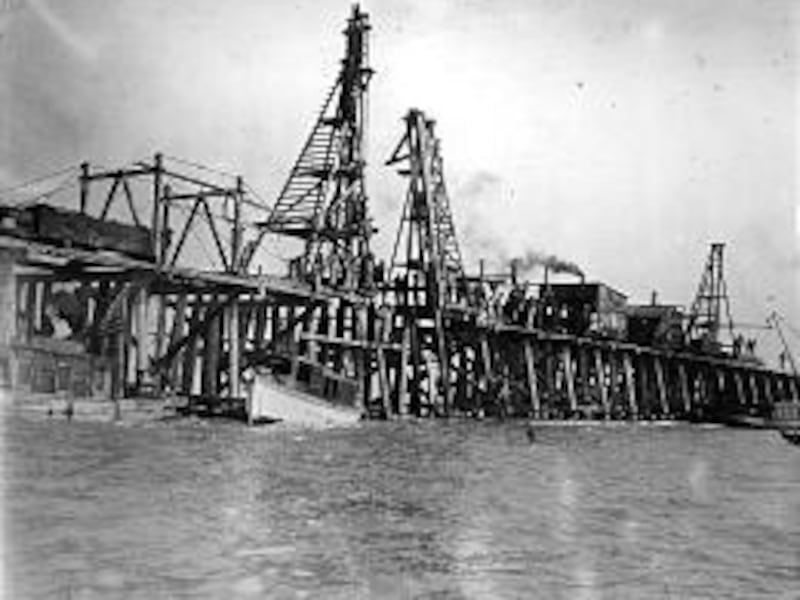Could a tsunami roar out of the Great Salt Lake?
Believe it or not, an earthquake-generated tsunami apparently did whip the lake into 12-foot waves in 1909. Another quake in 1934 may or may not have generated significant wave action.
This newspaper, known at the time as the Deseret Evening News, reported concerning the 1909 Hansel Valley Earthquake that Saltair Resort on the southern part of the Great Salt Lake swayed during the temblor.
"The lake was set in motion to a marked degree and waves were started rolling over the bathhouse pier," adds the Oct. 6, 1909, report, which is posted on the Utah Seismograph Stations' web site, www.seis.utah.edu/lqthreat/nehrp_htm/1909hans/n1909ha1.shtml#tevsl.
A cat was so frightened it jumped from the Saltair building into the lake and did not reappear.
"Many of the buildings today show evidences of the severity of the shock, being twisted, boards cracked and leaning far from the perpendicular.
"At Lucin cut-off the lake was rolling high and waves passed over the structure."
The last sentence is the most important, in terms of deciding if a tsunami would be possible on Utah's inland sea.
A geologist named Mike Low wrote that the old wooden railroad trestle was 12 feet above the lake's surface, meaning the waves had to be higher than that.
"I have to admit that seems pretty high to me for a magnitude 6 quake, but that's all the information we have, really," said Jim Pechmann, seismologist with the University of Utah Seismograph Stations.
The account suggests to him that the earthquake might have occurred beneath the lake, causing displacement of the lake bottom, in order to generate such a wave.
A number of earthquake faults crisscross the lake. "In particular, there's a major fault called the Great Salt Lake Fault that runs along the west side of Antelope Island and Fremont Island and then Promontory range," he said.
That doesn't mean the 1909 quake necessarily happened on that fault line. Earthquakes of less than magnitude 6.5 can occur on relatively small faults, ones that don't necessarily reach the surface and may not be obvious before the earth shakes.
"Usually, in order to actually displace the surface you need an earthquake greater than magnitude 6.5," he said. "Another way you can generate waves is by underwater landslides, but there really isn't that much topography under the lake."
Based on how far away the '09 earthquake was felt, seismologists think it was about a 6, not a 6.5. "Twelve feet (waves) seems pretty big for me for only a magnitude 6 or so earthquake. And so it's possible there was some exaggeration there."
But some sort of wave surge was generated by the earth movement, even if it didn't wash across the trestle. And just possibly it did: A strong storm can kick up big waves on the lake, because the lake water is so dense with brine that it packs more wallop than ordinary sea water.
"I think there was probably a wave," Pechmann said. "I think the height estimate may be right, (or) maybe it was exaggerated."
In 1934, another Hansel Valley earthquake, near the Great Salt Lake's northern arm, may have generated a tsunami-type wave — or may not have. That earthquake was an estimated 6.6.
The evidence we have is from an Idaho Falls Post-Register article that year stating, "The north end of Great Salt Lake pushed out over the landscape after the first shock and spread its salty water over an area of about two miles beyond its normal bounds. Within 12 hours the water receded again, leaving great ponds in the lower places."
A wave is not necessarily the explanation for this event, said Pechmann. "I'm more inclined to think that shaking up . . . water-saturated sediments (of the land) caused water to come out on the surface."
A better example of a tsunami-type wave on a lake caused by an earthquake was the 1959 Hebgen Lake killer temblor, which hit the vicinity of Yellowstone National Park, a monstrous 7.5 quake.
"That one caused large waves in Hebgen Lake that went on for several hours and were more than 10 feet high, and overlapped Hebgen Dam several times," he said. The waves started when the bottom of the lake suddenly tilted toward the fault.
Could a giant wave wash out of the Great Salt Lake and cause damage? It depends on the lake's height.
"If the lake level was high, then you could potentially get some damage from large earthquake-generated waves in the lake." With the greatest bottom displacement that seems at all likely, waves of 10 to 20 feet, maximum, could hit, he guessed.
I-80 as well as the Salt Lake International Airport are potential victims of wave damage.
But that won't happen any time soon, even if a big quake hit beneath the lake. With the six-year drought, the Great Salt Lake's surface is 18 feet lower than in the 1980s, he noted.
With a 20-foot wave, that won't make much impact. Also, the water depth is only 10 to 20 feet, not enough to build up a gigantic wave. But the lake goes through cycles, and undoubtedly will rise again.
"Yes, this is a potential hazard and it could happen," Pechmann said. But even in anyone's worst nightmare, the waves could not do any damage comparable to the destruction suffered recently by those living around the Indian Ocean.
E-mail: bau@desnews.com


